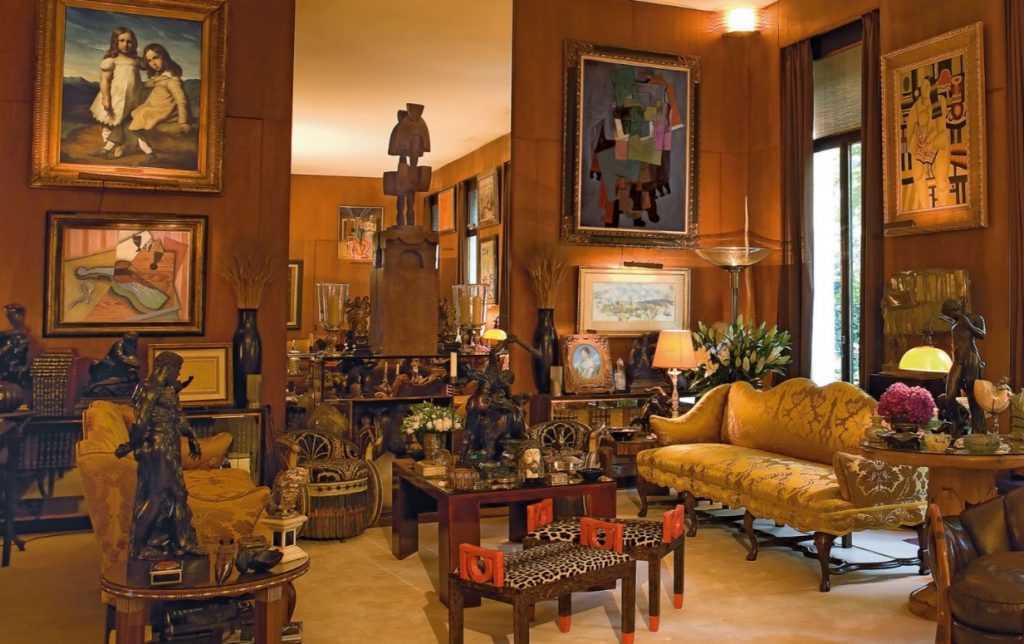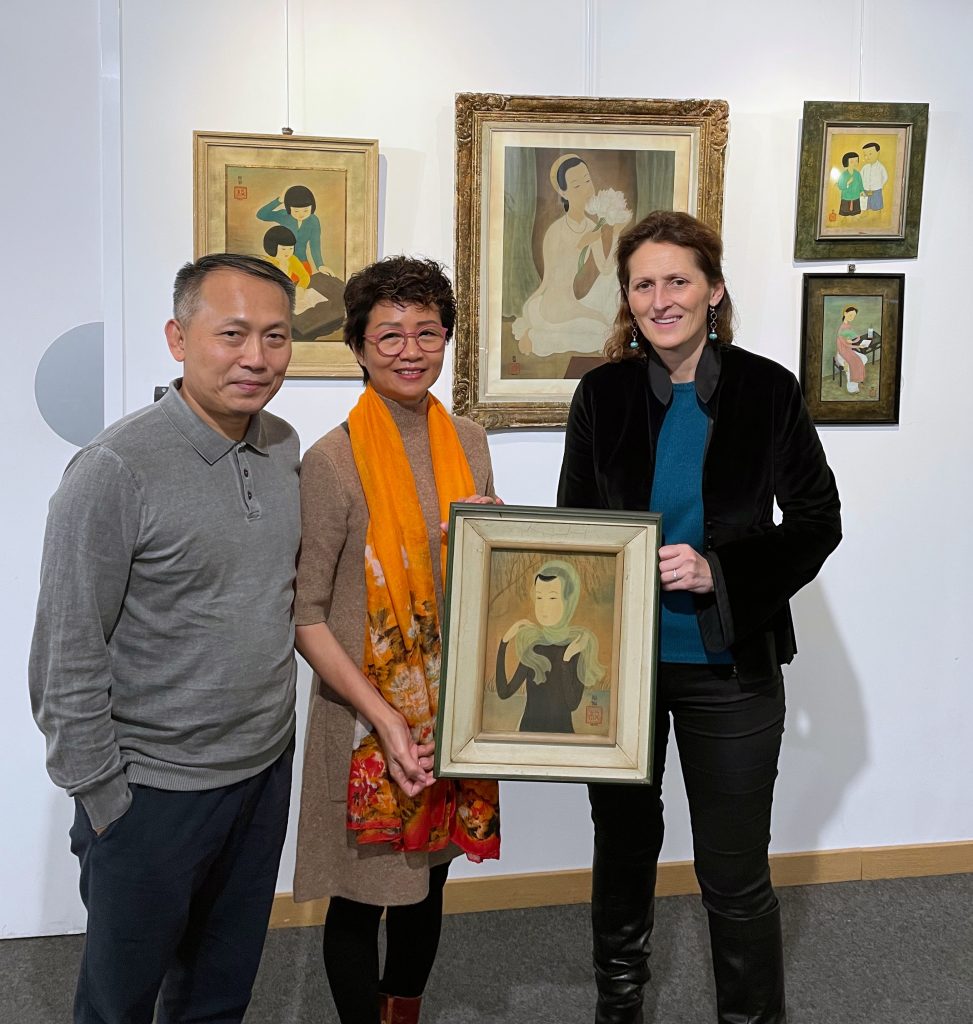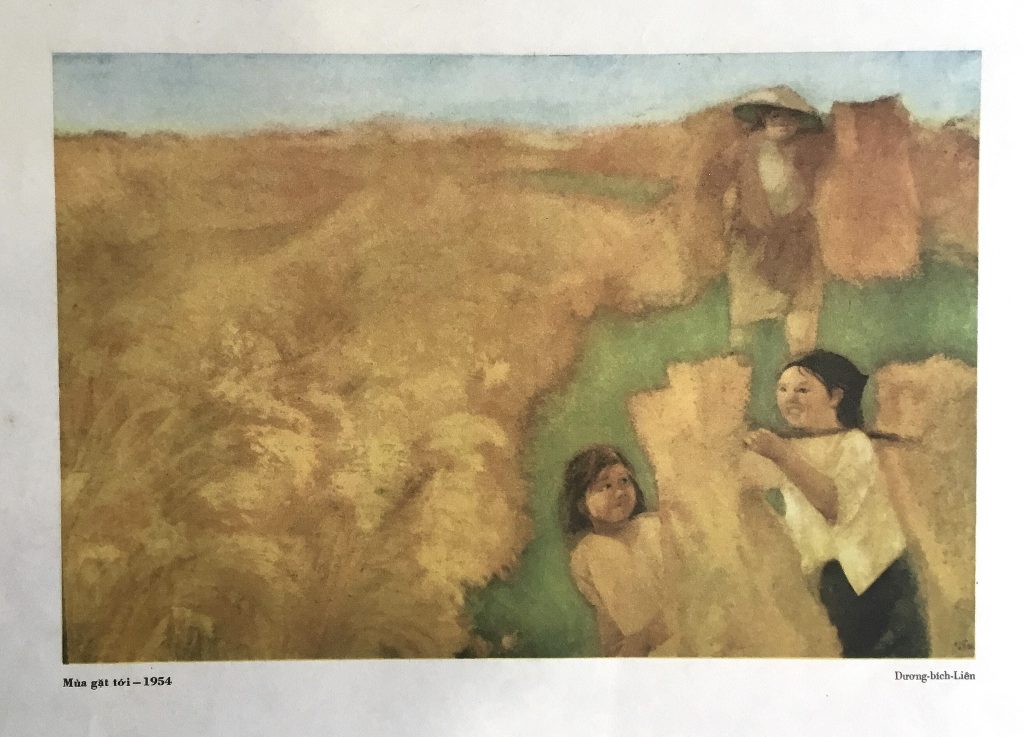
MAI TRUNG THỨ (1906-1980). Artwork: ‘L’écharpe bleue’* (named by the artist). Dated: 1942. Medium: Silk. Dimension: 30,5×22cm.
From a historical painting…
On November 24, 2010, at Millon, France, in the ‘Modern and Contemporary Art’ auction, there was a very special painting. It was the oil painting ‘Sunset’, dated 1915, dimensions 35×46 cm, by King Hàm Nghi (1871-1944). This is also the first painting by King Hàm Nghi to appear at an auction. The price started at 800- 1,000 EUR and was pushed up very quickly, after 10 minutes it was 8,800 EUR, from a bidder on the phone. It was the French doctor Gérard Chapuis, of Vietnamese origin, living in Marseille, got the painting.

King Hàm Nghi (1871-1944). Sunset. 1915. Oil. 35×46 cm.
In Vietnamese history, King Hàm Nghi’s real name is Nguyễn Phúc Ưng Lịch. When he ascended the throne, he changed his name to Nguyễn Phúc Minh. He was the fifth child of King Kiên Thái- Nguyễn Phúc Hồng Cai and Phan Thị Nhàn, born on June 17, year of the Sheep, ie August 3, 1871 (there are documents stating that he was born on July 22, 1872) in Huế. He is the younger brother of King Kiến Phúc (Ưng Đăng) and King Đồng Khánh (Chánh Mông or Ưng Kỷ). Hàm Nghi along with King Thành Thái and Duy Tân were the three patriotic kings during the French colonial period.
At 4:00 a.m. on November 25, 1888, King Hàm Nghi was taken off the train to Lăng Cô. On the afternoon of Sunday, January 13, 1889, the king arrived in the Algerian capital, Alger, started living in exile in a foreign land until his death, 1944.

King Hàm Nghi – Self portrait July 24th, 1896
In 1896, in a situation of coercion, King Hàm Nghi came to painting with the patriotism and national pride of a clear-sighted king when he made the first self-portrait in charcoal. This self-portrait is based on a photograph taken when the king was in exile for a few years and the outfit in the photo is still a pure Vietnamese royal style. He then mass-printed the work and gave it to everyone he met as a name card, as was customary at the time. But the main purpose was to say: “I am still the king of Annam and the French cannot subdue the patriotism and national pride of a king like me.” (According to Nhã Khai).
Because of these thoughts and actions, Hàm Nghi has become a symbol of the patriotism of the Vietnamese people. Therefore, stories around life, career, everything related to King Hàm Nghi are of special interest. That explains why the painting ‘Sunset’ of King Hàm Nghi was auctioned at a high price; at a time when Vietnamese people still know little about international auctions.
To the auction of ‘L’écharpe bleue’ by Mai Trung Thứ
Viet Art View would like to look back in the history because the painting ‘L’écharpe bleue’ introduced here has a special life. The painting was created by painter Mai Trung Thứ and owned by King Hàm Nghi. These are two legendary names of Vietnamese political and artistic history.

Famous painter Mai Trung Thứ (1906-1980). Photo taken in 1942, Paris, France.

Galerie dArt Pasteur – Alger, Oran – Exposition Mai Thứ- Lê Phổ- Vũ Cao Đàm- Peintures Indo-Chinoises (cir 1942-1944)

Three painters displayed their works at the exhibition

List of the paintings displayed in the exhibition – Trois Peintres Indochinois- Cir 1942-1944

Gaston POULAIN – Trois Peintres Indochinois – Cir 1942-1944
Mr. Hàn Ngọc Vũ, the new owner of ‘L’écharpe bleue’ shared: “In October 2022, during a business trip, I stopped in France to visit the art gallery before the auction ‘Peintres & Arts du Vietnam – Painting and art of Việt Nam’ at Aguttes. I met Ms. Charlotte Aguttes-Reynier- Artistic Director of Aguttes. The two sides had very sincere sharing stories about art. Ms. Charlotte especially noticed me the painting ‘L’écharpe bleue – Green scarf’ by Mai Trung Thứ; the work that was once in King Hàm Nghi’s Art Collection. When I look at the painting, I have strange vibrations. I think that each work of art brings to the viewer emotions about visual beauty, evoking imagination and the desire to discover about the content of people, scenes, and themes in it. With works whose existence has spanned many historical ups and downs, passed through the storage space and enjoyed by many famous witnesses, our curiosity about the work will be so much deeper. The silk painting ‘L’écharpe bleue’ is such a work.”

Mr. Hàn Ngọc Vũ, the new owner of ‘L’écharpe bleue’. Photo taken in November, 2022 in Viet Art View studio.
In fact, Mai Trung Thứ is one of the Vietnamese painters whose works are the most loved, the auction prices are also the highest, always getting more expensive over time. Currently, the record for the most expensive painting of Vietnam still belongs to a painting by Mai Trung Thứ. It is ‘Portrait of Miss Phượng’ for 3.1 million USD. A vermilion mark for Vietnamese painting.

MAI TRUNG THỨ. Portrait of Ms Phượng. 1930. Oil. 135,5×80 cm.
Compared to a painting with the same theme and similar size by Mai Trung Thứ, ‘L’écharpe bleue’, size 30.5×22cm, is only a little expensive. But in terms of profound semantics, this painting was once owned by King Hàm Nghi. This is what creates real value for the work.
The ‘visible’ and ‘invisible’ value of an artwork
The value of an artwork includes the concept of ‘visible’ and ‘invisible’. The ‘visible’ value is the beauty of the picture itself and the name of the artist. The ‘invisible’ value is the stories surrounding the work. It can be history, provenance, owner, context that the painting has been through. A painting with a rich life, once in famous collections; if placed in the right ‘historical focus’, the work itself becomes very valuable.

Yves Saint Laurent’s salon at rue de Babylone, Paris, 2009
In the article ‘Jonathan Rendell: How I look at a house’ (Christie’s), Mr. Jonathan Rendell, Christie’s Deputy Chairman said: ‘I go into a house as an anthropologist looking for fetishes, seeking out the things that sum up the person to whom the objects belonged. Sometimes that thing might have little or no intrinsic worth at all — like the Rockefeller moneyclip. For me, that object said everything about the Rockefellers, about New York in the Thirties and Forties, about wealth and status. It was all in one tiny little thing.
‘And people will grab onto that. If you were a banker in Manhattan, wouldn’t you want to own a moneyclip that once belonged to the Rockefellers? It places you, the buyer, in the same relation to the object as the people who owned it before. That is why provenance is so important. Provenance is everything, in fact: where a piece comes from matters as much as what it is.’
The above opinions of Mr. Ronathan Redell are very accurate, drawn from his practical experience, after 30 years of working at Christie’s.
Thus, it can be understood why the painting ‘Sunset’ by King Hàm Nghi, after the 2010 auction in Millon (France) was published by many media as a big event. Currently, the commercial value of ‘Sunset’ is difficult to estimate because the historical value of “a painting created by a king” has surpassed conventional quantitative frameworks.

Photo of King Bảo Đại in Switzerland, 1954, when he was in Geneva (Switzerland) to attend the Indochina Diplomatic Conference (Website X Watch)
Objects that were once owned by the royal families, with aristocratic provenance are always searched and sought after. May 2017, Rolex Reference 6062 Oyster Perpetual watch, owned by King Bảo Đại became the most expensive watch in human history when it was sold at 5 million USD (114 billion VND, the exchange rate at that time) in an auction at the Hôtel La Réserve in Geneva (Switzerland).
Most recently, in October 2022, Millon also presented the gold seal ‘Hoàng Đế chi bảo’, the Nguyễn Dynasty, owned by King Bảo Đại. Before the auction, a huge wave of public opinion about the repatriation of the golden seal was paid special attention by The State and the descendants of the Nguyễn. After secret negotiations with a secret price, ‘Hoàng Đế chi bảo’ was officially prepared to be returned to its homeland. Certainly, the gold seal ‘Hoàng Đế chi bảo’ is placed on a different level. But all items with historical, royal origin will certainly be very expensive.

The golden seal ‘Hoàng Đế chi bảo’
Seeing ‘L’écharpe bleue’, think of Vietnamese consciousness
Mai Trung Thứ’s ‘L’écharpe bleue’, a small silk painting, depicts a young woman with Mai Trung Thứ’s signature visual style. It is easy to see that this is the style throughout the quartet of Phổ, Thứ, Lựu, Đàm… Nostalgia for far away from home, the image of homeland was always in the mind, transformed into beautiful paintings…
Lived in France, Mai Trung Thứ couldn’t help thinking about his homeland… He made many paintings about Vietnam, including ‘L’écharpe bleue’… Therefore, shaping of the characters; scene; space imbued with Vietnamese culture. The tender image of the young woman reminds Viet Art View of Thánh Mẫu [the Holy Mother]. The image of the Holy Mother contains the ideological, emotional, and personality characteristics of the Vietnamese women and Vietnamese nation; especially Vietnamese cultural traditions and folk beliefs. The Holy Mother with an angel face, gentle eyes, exuding protection, lenience, generosity… The soft hands, full of femininity, gentleness and flexibility, purify emotions, cultivate good heart. The decorative details are bold in the style of Vietnamese folk decorative patterns, especially the decorative motifs in the splendid palaces of Huế ancient capital, represented by Mai Trung Thứ on frames which he designed and completed. There are even paintings, such as ‘L’écharpe bleue’, although he did not directly complete the frame, but he clearly stated (on the back of the painting) how to design the frame to best suit. This is a difference of Mai Trung Thứ from most other painters.

Statue of The Holy Mother in Phủ Nấp, Nam Định
‘L’écharpe bleue’ was auctioned in France, then was brought to Vietnam
In fact, compared to some works on the subject of young women by Mai Trung Thứ, ‘L’écharpe bleue’ is not among the best works. But the painting is made special by its own story.
According to documents from Aguttes: ‘From the collection of Princess Hàm Nghi in Algeria, this young woman’s elegance is undeniable. Hàm Nghi, the prince of Annam, had been in exile in Algeria since 1888 following an uprising against the French presence in Tonkin. He discovered a gift for painting and a passion for Fine Arts. Thus, he got in touch with many artists, among whom Georges Rochegrosse, Auguste Rodin, Paul Gauguin… He painted, sculpted and collected works of art. In 1904, he married Marcelle Laloë, the daughter of the president of the Court of Appeal of Algiers, who gave him 3 children. The Prince and the Princess of Annam met Mr. X when they built the villa Gia Long in El-Biar. The Prince died in 1944 but Mr. X and his family remained close to his widow and children. The Princess of Annam offered him the painting of Mai Thu, acquired at the Galerie d’Art Pasteur in Algiers, as a token of her friendship and as a reward for many services. She then resided in the family castle in Périgord until her death in 1974. While the descendants of Mr. X will settle for their part in the South-East of France.’
With a provenance of a royal family, Mai Trung Thứ’s ‘L’écharpe bleue’ was particularly noted by Mr. Hàn Ngọc Vũ. He shared: “Although there have been several silk paintings of this subject, this period of Mai Trung Thứ has fascinated me, but I do not own any, simply because of their high price. However, ‘L’écharpe bleue’ makes me much more interested because of the historical journey that the work has gone through. Imagine, a Vietnamese painter who graduated from the first class of the first fine art school in Indochina founded and guided by the French, lived in France for many reasons, but also because of the war, when France was the weak side, it was not convenient for exhibitions in the country occupied by Nazi Germany, so they found a way to go to another French colony, Algeria, to exhibit painting.
“And in Algeria, a king of another French colony, King Hàm Nghi of Vietnam, was living a life of unexpected exile with his French wife whom he married according to his will and love. Why did King Hàm Nghi and his wife choose to buy the painting ‘L’écharpe bleue’ by Mai Trung Thứ? Hàm Nghi or his wife who chose the painting? Did they meet Mai Trung Thứ and buy the painting during the 1942 exhibition in Alger, or later when the exhibition was over? Where did Hàm Nghi hang this painting, invite anyone to see it, before he died just a few years later, in 1944?”

At Aguttes auction, October 3rd, 2022

From left to right: Mr. Hàn Ngọc Vũ and his wife, Ms. Thạch Lê Anh, Ms. Charlotte Aguttes-Reynier – Artistic Director of Aguttes, at Aguttes Office Neuilly sur Seine on November 25, 2022 (when Mr. Hàn Ngọc Vũ and his wife returned to France, bringing the painting to Vietnam after many procedures related to the license).

One page of Export License

The back of the painting ‘L’écharpe bleue’
The above thoughts of Mr. Hàn Ngọc Vũ are common for art collectors. When encountering a beautiful, valuable, special painting, they all have thoughts and considerations. The decision to buy or not to buy depends on these two things.
And finally, Mr. Hàn Ngọc Vũ decided: “A lot of questions have arisen to which I know for sure the answers can only be conjecture. Only one conclusion was made, that was, it was necessary to buy the ‘L’écharpe bleue’ and bring the painting back to Vietnam.”
Written by Viet Art View
Copyrights belong to Viet Art View







